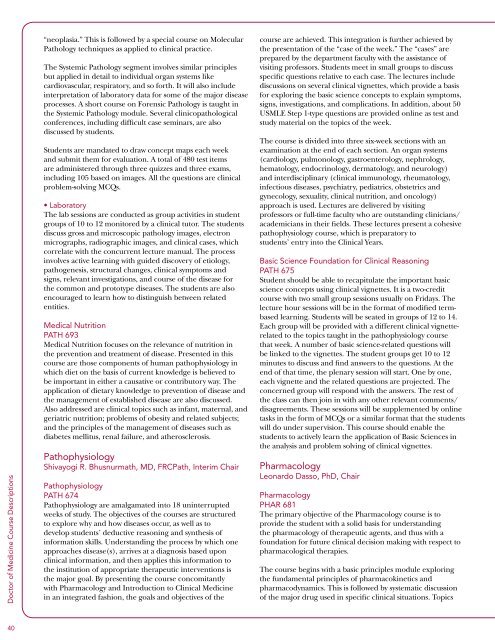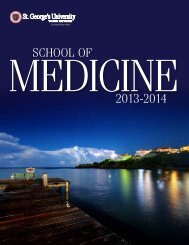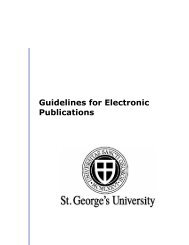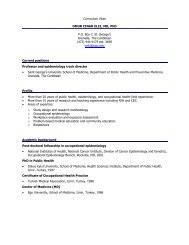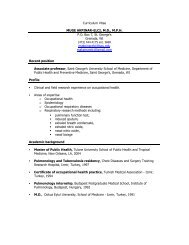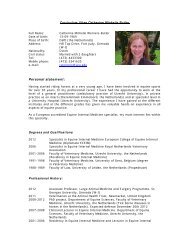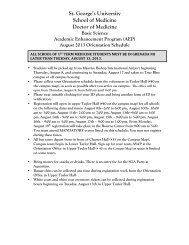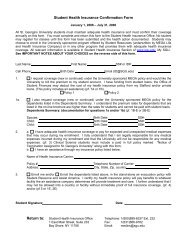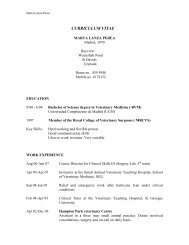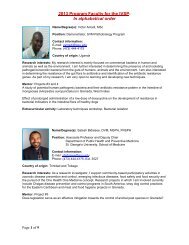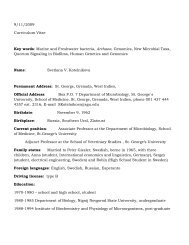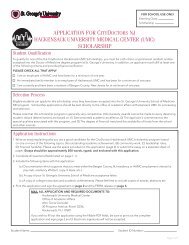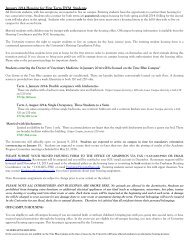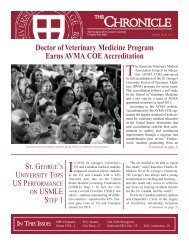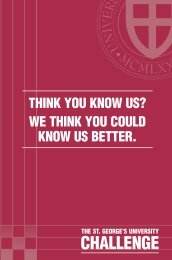ST. GEORGE'S UNIVERSITY ⢠School of Medicine 2010-2011
ST. GEORGE'S UNIVERSITY ⢠School of Medicine 2010-2011
ST. GEORGE'S UNIVERSITY ⢠School of Medicine 2010-2011
Create successful ePaper yourself
Turn your PDF publications into a flip-book with our unique Google optimized e-Paper software.
Doctor <strong>of</strong> <strong>Medicine</strong> Course Descriptions<br />
“neoplasia.” This is followed by a special course on Molecular<br />
Pathology techniques as applied to clinical practice.<br />
The Systemic Pathology segment involves similar principles<br />
but applied in detail to individual organ systems like<br />
cardiovascular, respiratory, and so forth. It will also include<br />
interpretation <strong>of</strong> laboratory data for some <strong>of</strong> the major disease<br />
processes. A short course on Forensic Pathology is taught in<br />
the Systemic Pathology module. Several clinicopathological<br />
conferences, including difficult case seminars, are also<br />
discussed by students.<br />
Students are mandated to draw concept maps each week<br />
and submit them for evaluation. A total <strong>of</strong> 480 test items<br />
are administered through three quizzes and three exams,<br />
including 105 based on images. All the questions are clinical<br />
problem-solving MCQs.<br />
• Laboratory<br />
The lab sessions are conducted as group activities in student<br />
groups <strong>of</strong> 10 to 12 monitored by a clinical tutor. The students<br />
discuss gross and microscopic pathology images, electron<br />
micrographs, radiographic images, and clinical cases, which<br />
correlate with the concurrent lecture manual. The process<br />
involves active learning with guided discovery <strong>of</strong> etiology,<br />
pathogenesis, structural changes, clinical symptoms and<br />
signs, relevant investigations, and course <strong>of</strong> the disease for<br />
the common and prototype diseases. The students are also<br />
encouraged to learn how to distinguish between related<br />
entities.<br />
Medical Nutrition<br />
PATH 693<br />
Medical Nutrition focuses on the relevance <strong>of</strong> nutrition in<br />
the prevention and treatment <strong>of</strong> disease. Presented in this<br />
course are those components <strong>of</strong> human pathophysiology in<br />
which diet on the basis <strong>of</strong> current knowledge is believed to<br />
be important in either a causative or contributory way. The<br />
application <strong>of</strong> dietary knowledge to prevention <strong>of</strong> disease and<br />
the management <strong>of</strong> established disease are also discussed.<br />
Also addressed are clinical topics such as infant, maternal, and<br />
geriatric nutrition; problems <strong>of</strong> obesity and related subjects;<br />
and the principles <strong>of</strong> the management <strong>of</strong> diseases such as<br />
diabetes mellitus, renal failure, and atherosclerosis.<br />
Pathophysiology<br />
Shivayogi R. Bhusnurmath, MD, FRCPath, Interim Chair<br />
Pathophysiology<br />
PATH 674<br />
Pathophysiology are amalgamated into 18 uninterrupted<br />
weeks <strong>of</strong> study. The objectives <strong>of</strong> the courses are structured<br />
to explore why and how diseases occur, as well as to<br />
develop students’ deductive reasoning and synthesis <strong>of</strong><br />
information skills. Understanding the process by which one<br />
approaches disease(s), arrives at a diagnosis based upon<br />
clinical information, and then applies this information to<br />
the institution <strong>of</strong> appropriate therapeutic interventions is<br />
the major goal. By presenting the course concomitantly<br />
with Pharmacology and Introduction to Clinical <strong>Medicine</strong><br />
in an integrated fashion, the goals and objectives <strong>of</strong> the<br />
course are achieved. This integration is further achieved by<br />
the presentation <strong>of</strong> the “case <strong>of</strong> the week.” The “cases” are<br />
prepared by the department faculty with the assistance <strong>of</strong><br />
visiting pr<strong>of</strong>essors. Students meet in small groups to discuss<br />
specific questions relative to each case. The lectures include<br />
discussions on several clinical vignettes, which provide a basis<br />
for exploring the basic science concepts to explain symptoms,<br />
signs, investigations, and complications. In addition, about 50<br />
USMLE Step 1-type questions are provided online as test and<br />
study material on the topics <strong>of</strong> the week.<br />
The course is divided into three six-week sections with an<br />
examination at the end <strong>of</strong> each section. An organ systems<br />
(cardiology, pulmonology, gastroenterology, nephrology,<br />
hematology, endocrinology, dermatology, and neurology)<br />
and interdisciplinary (clinical immunology, rheumatology,<br />
infectious diseases, psychiatry, pediatrics, obstetrics and<br />
gynecology, sexuality, clinical nutrition, and oncology)<br />
approach is used. Lectures are delivered by visiting<br />
pr<strong>of</strong>essors or full-time faculty who are outstanding clinicians/<br />
academicians in their fields. These lectures present a cohesive<br />
pathophysiology course, which is preparatory to<br />
students’ entry into the Clinical Years.<br />
Basic Science Foundation for Clinical Reasoning<br />
PATH 675<br />
Student should be able to recapitulate the important basic<br />
science concepts using clinical vignettes. It is a two-credit<br />
course with two small group sessions usually on Fridays. The<br />
lecture hour sessions will be in the format <strong>of</strong> modified termbased<br />
learning. Students will be seated in groups <strong>of</strong> 12 to 14.<br />
Each group will be provided with a different clinical vignetterelated<br />
to the topics taught in the pathophysiology course<br />
that week. A number <strong>of</strong> basic science-related questions will<br />
be linked to the vignettes. The student groups get 10 to 12<br />
minutes to discuss and find answers to the questions. At the<br />
end <strong>of</strong> that time, the plenary session will start. One by one,<br />
each vignette and the related questions are projected. The<br />
concerned group will respond with the answers. The rest <strong>of</strong><br />
the class can then join in with any other relevant comments/<br />
disagreements. These sessions will be supplemented by online<br />
tasks in the form <strong>of</strong> MCQs or a similar format that the students<br />
will do under supervision. This course should enable the<br />
students to actively learn the application <strong>of</strong> Basic Sciences in<br />
the analysis and problem solving <strong>of</strong> clinical vignettes.<br />
Pharmacology<br />
Leonardo Dasso, PhD, Chair<br />
Pharmacology<br />
PHAR 681<br />
The primary objective <strong>of</strong> the Pharmacology course is to<br />
provide the student with a solid basis for understanding<br />
the pharmacology <strong>of</strong> therapeutic agents, and thus with a<br />
foundation for future clinical decision making with respect to<br />
pharmacological therapies.<br />
The course begins with a basic principles module exploring<br />
the fundamental principles <strong>of</strong> pharmacokinetics and<br />
pharmacodynamics. This is followed by systematic discussion<br />
<strong>of</strong> the major drug used in specific clinical situations. Topics<br />
40


